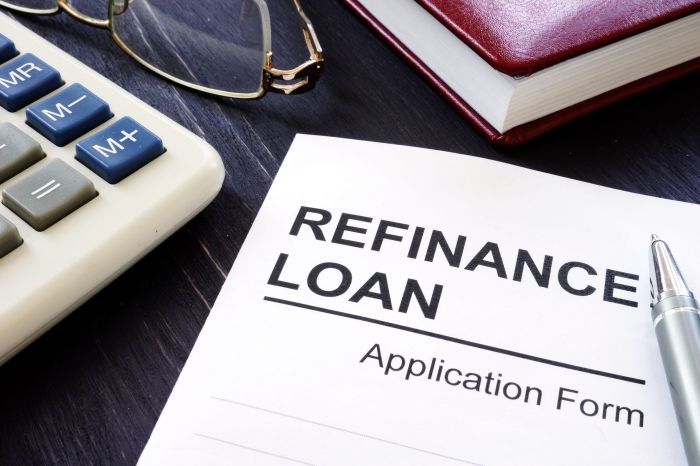Get ready to dive into the world of Mortgage refinancing options where the possibilities are endless. With a mix of cash-out refinancing and rate-and-term refinancing, homeowners are in for a treat. Let’s explore the ins and outs of this financial game-changer.
In this guide, we’ll break down the different types, benefits, considerations, and the process of mortgage refinancing, giving you the keys to unlock a world of financial opportunities.
Types of Mortgage Refinancing Options
When it comes to mortgage refinancing, there are two main options to consider: cash-out refinancing and rate-and-term refinancing. Each option has its own benefits and considerations, depending on your financial goals and situation.
Cash-Out Refinancing
Cash-out refinancing allows you to access the equity in your home by refinancing for more than you owe on your current mortgage. The difference between the new loan amount and your existing mortgage is given to you in cash. This can be beneficial if you need funds for home improvements, debt consolidation, or other big expenses. However, it’s important to remember that this option increases your loan amount and could lead to higher monthly payments.
Rate-and-Term Refinancing
Rate-and-term refinancing, on the other hand, involves refinancing your mortgage to secure a lower interest rate or change the term of your loan. This can help you save money on interest over time or pay off your loan faster. Rate-and-term refinancing is a good option if you want to take advantage of lower interest rates or adjust your loan term to better fit your financial goals.
Overall, the best refinancing option for you will depend on your specific financial needs and objectives. Consider factors like your current interest rate, loan term, and long-term financial goals when deciding between cash-out refinancing and rate-and-term refinancing.
Benefits of Mortgage Refinancing
Refinancing a mortgage can offer homeowners several potential benefits that can help them achieve their financial goals. Whether it’s lowering monthly payments, shortening the loan term, or tapping into equity for other needs, refinancing can be a smart financial move.
Lower Monthly Payments
By refinancing your mortgage, you may be able to secure a lower interest rate, which can result in reduced monthly payments. This can free up more money in your budget for other expenses or savings, providing you with greater financial flexibility.
Shorten Loan Term
Refinancing also gives homeowners the opportunity to shorten the term of their loan. By switching to a shorter loan term, you can pay off your mortgage faster and save on interest payments over the life of the loan. This can help you build equity in your home more quickly and achieve financial freedom sooner.
Tap into Equity
Another benefit of refinancing is the ability to tap into the equity you’ve built in your home. By refinancing for a higher amount than your current mortgage balance, you can access cash that can be used for home improvements, debt consolidation, education expenses, or other financial goals. This can be a valuable resource for homeowners looking to leverage their home’s value for additional financial opportunities.
Considerations Before Refinancing
Before deciding to refinance a mortgage, there are several important factors to consider. Your credit score, debt-to-income ratio, and changes in interest rates can all impact your refinancing options.
Impact of Credit Scores and Debt-to-Income Ratios
When considering refinancing, your credit score plays a crucial role in determining the interest rate you may qualify for. A higher credit score typically translates to better refinancing terms, such as lower interest rates. Additionally, lenders also look at your debt-to-income ratio, which is the percentage of your monthly income that goes towards paying debts. A lower ratio is usually more favorable when refinancing, as it shows lenders that you can manage your debts responsibly.
Influence of Interest Rate Changes
Changes in interest rates can greatly influence the decision to refinance. If interest rates have dropped since you initially took out your mortgage, refinancing at a lower rate could potentially save you money in the long run. On the other hand, if rates have increased, refinancing may not be as beneficial unless you are able to secure a significantly lower rate than your current one. It’s important to carefully consider the current interest rate environment before making a decision to refinance.
Process of Mortgage Refinancing

When it comes to refinancing your mortgage, there are several steps involved in the process. From gathering documentation to understanding the costs and timeline, it’s essential to be prepared for what lies ahead.
Steps Involved in Refinancing a Mortgage
- Evaluate Your Current Mortgage: Assess your current mortgage terms and compare them with the new loan options available.
- Research Lenders: Look for reputable lenders and compare their rates and terms to find the best fit for your financial goals.
- Submit Application: Complete the refinancing application and provide all required documentation to the lender.
- Appraisal and Underwriting: The lender will conduct an appraisal of your property and review your financial information to approve the loan.
- Closing: Sign the new loan documents, pay any closing costs, and officially refinance your mortgage.
Documentation Needed for a Refinancing Application
- Proof of Income: Recent pay stubs, W-2s, or tax returns to verify your income.
- Asset Information: Bank statements, investment accounts, and other assets to show your financial stability.
- Credit History: Credit report and score to assess your creditworthiness.
- Property Information: Property appraisal, insurance, and other details related to your home.
Timeline and Costs Associated with Refinancing a Mortgage
- Timeline: The refinancing process typically takes anywhere from 30 to 45 days, depending on the lender and complexity of the loan.
- Costs: Refinancing costs may include application fees, appraisal fees, title insurance, and closing costs, which can add up to thousands of dollars.
